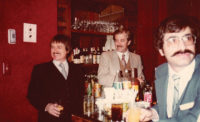In the world of contents restoration, there are a number of niche areas: textiles, furniture, electronics, etc. It seems a lot of people are ready to tackle that first category hands-on. But how knowledgeable are you when it comes to grandma’s antique dining table damaged by fire? Or matching the types of wood in a marquetry piece cracked from taking on water in a flood?
O’Donnell Brothers Professional Furniture Service, based in the Metro Detroit area, has been doing furniture restoration for decades, and grown exponentially. In 1988, they had just three employees in a 1,200 square foot space. Today, they’ve grown into a more than 125,000 square foot space and more than 50 employees with locations in Metro Detroit and Grand Rapids. Ninety-nine percent of their business is insurance work.
Owner Mike O’Donnell says he believes there is a big revolution coming in contents restoration – one that has to do with training and education. By June of this year, the company had already handled 480 pack-outs, and was well on track to hit the one-thousand mark by the end of the year.
Enter now Eric Blumenstein, finishing department manager. With a background in antique furniture restoration and preservation and training through the Smithsonian, he knows his stuff – right down to the ability to match a stain color by just looking at it. He has a wealth of expertise thanks to years of hands-on experience, research and learning, and his knowledge is helping O’Donnell Brothers restore furniture like never before.
“I’ve been doing this since about 1990,” Blumenstein said. “I was in an office job and hated it, so we opened an antique store but realized you can’t make a lot of money doing that, so I figured I would learn restoration work because I always liked working with my hands, doing finishing.”
After several twists in the road, Blumenstein landed at Michigan Antique Preservation Company.
“That owner actually sent me to classes through the Smithsonian and I learned certain aspects of antique conservation and restoration,” he said. At this job, he handled museum-type pieces that would often take six months to a year to restore, and require very technical, skilled work.
When the recession hit, Blumenstein was forced to look for a new job and landed in production shop – making furniture for office buildings, hotels, and beyond. That lasted about five years.
Today, he’s been with O’Donnell Brothers for three and a half years, and it sounds like a good fit.
“This is what I enjoy doing the most, by far. It’s different every day,” Blumenstein said. And now his training comes back into play. Through the Smithsonian, Blumenstein learned how to look at small samples, or cross sections, from a damaged piece of furniture under a microscope and analyze all the layers of finish, dirt, etc.
“Then, you can actually analyze what’s been done to that piece through time,” he explained. “Learning chemistry helped me learn about making solvents work for me, and work to restore and preserve pieces. We do testing with certain solvents to see what might work.
“We use proprietary solvent mixtures I come up with based on what the damage is. If it’s fire, we use fire washes which are commercially available, but sometimes we need to make our own solvents which is where my chemistry background comes into play,” Blumenstein said. He went on to explain how making his own solvents helps him carefully restore each piece individually. Every piece is slightly different – whether you’re cleaning off polish applied to the furniture by the owner, or trying to clean off soot damage.
Blumenstein pointed out how damaging some oil-based “cleaners” can be for furniture. If a piece of furniture comes in with polish on it (like lemon oil), they have to get it off before starting the restoration process. If they spray lacquer onto a surface with petroleum on it, it creates surface tension – and can cause cratering and damage to the wood. In the finishing world, it’s called “fish eyes.”
At O’Donnell Brothers, they are able to save about 95 percent of the pieces that come in, should it be worth it – like antiques. When it comes to new furniture, many times it’s more cost effective for insurance companies to pay for full replacement rather than restoration.
Here are the steps a piece goes through, managed through software called Contents Track.
- Get a lead/call about a loss.
- Assign an estimator who then looks at the damage.
- Send out a crew to do the pack-out.
- Evaluate the piece: Is it cost-effective to repair it?
a. If yes – put a price on it to restore it back to pre-loss condition. Blumenstein emphasized the importance of pre-loss condition, meaning damage there before the loss would not be included in the restoration. But normally, items are returned better than pre-loss condition.
b. If no – let the insurance company know.
5. Restore it!
a. For fire pieces, the items will take on a lot of odor so there is more replacement involved, and perhaps time in the ozone room. Some pieces are in there 24 hours; some are there for up to a week. Again when it comes to replacement, it’s a matter of whether or not it’s cost effective. Sometimes, parts of furniture have to be completely refabricated. Blumenstein has the skill to do so, but it can be a costly endeavor if you’re talking about an intricate part of an antique.
b. For water-damaged pieces, it could just mean restoring or replacing feet that sat in standing water. If they find mold, they remediate it, rebuild the piece, or suggest it be replaced entirely.
c. One interesting thing of note: something called the powder post beetle. Blumenstein said these critters are mainly found in antique pieces, but he encountered them once at O’Donnell Brothers. Essentially, the bugs burrow tunnels through furniture, and can spread to others. They have to be chemically killed, or frozen.
Through Contents Track, anyone at O’Donnell Brothers can figure out where a piece is located in the massive warehouse, where it is at in the restoration process, read any notes on the item, see who it belongs to, see photos of the item, and more.
Despite all the training courses out there for restorers, the contents refinishing world is rather lacking. Blumenstein says the best way to learn the “business” is by being hands-on and actually doing the work.
“Eighty percent of restoring is in the prep,” he said about what he teaches people learning this trade. “If it’s not prepped right, then the finish isn’t going to come out right. This job is basically 75 to 80 percent thinking, and 20 to 25 percent doing. You need to think about what you’re doing first, because it will make things a lot easier on yourself and the end result will be much better. Don’t just jump in and try to do it.”









Report Abusive Comment